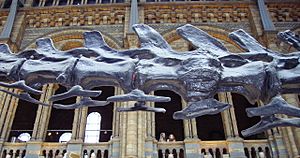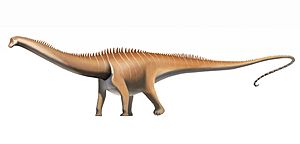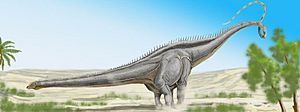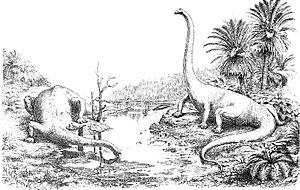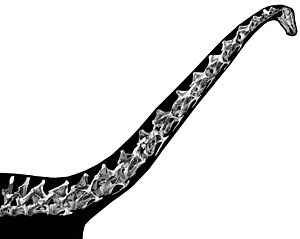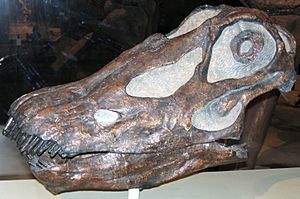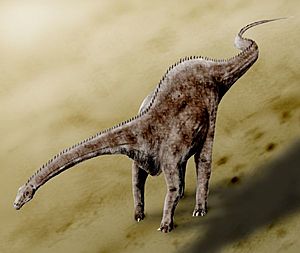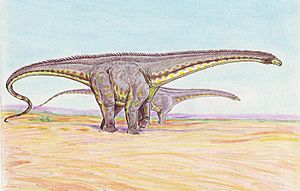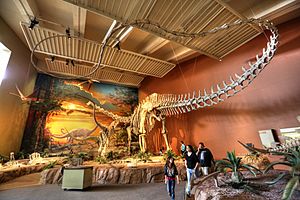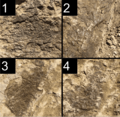Diplodocus facts for kids
Quick facts for kids DiplodocusTemporal range: Upper Jurassic
|
|
|---|---|
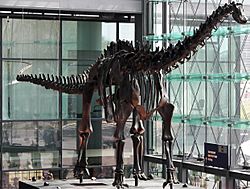 |
|
| Diplodocus carnegiei skeleton from the Museum für Naturkunde | |
| Scientific classification | |
| Kingdom: | |
| Class: | |
| Superorder: | |
| Order: | |
| Infraorder: | |
| Family: | |
| Genus: |
Diplodocus
Marsh, 1878
|
Diplodocus was a giant dinosaur that lived a very long time ago. It roamed the Earth during the Upper Jurassic period, about 145 to 155 million years ago. This huge plant-eater mostly munched on leaves using its special peg-like teeth. It lived at the same time as dinosaurs like Allosaurus.
Contents
What did Diplodocus look like?
Diplodocus was one of the most famous sauropods. These were very large animals with long necks and long, whip-like tails. They walked on four strong legs, with their front legs slightly shorter than their back legs. This gave them a mostly horizontal body shape.
Scientists have compared their skeleton to a suspension bridge. Diplodocus carnegii is one of the longest dinosaurs known from a complete skeleton. It could reach about 25 meters (82 feet) long. Its weight was usually between 10 to 16 metric tons. That's like two or three elephants!
How big was Diplodocus hallorum?
Another species, Diplodocus hallorum, was even bigger. It's thought to have been as large as four elephants. When it was first found in 1991, some thought it might have been 52 meters (171 feet) long. This would have made it the longest known dinosaur. However, later studies changed this estimate to about 32 to 33.5 meters (105 to 110 feet). This was because some bones were placed incorrectly at first.
What was special about its tail?
Diplodocus had an extremely long tail. It was made of about 80 tail bones, called caudal vertebrae. This is almost twice as many as some earlier sauropods had.
Scientists wonder if the tail was used for defense. Maybe it could crack like a whip to make a loud noise. The tail also likely helped balance its long neck. The middle part of the tail had special 'double beams' on the underside. These bones gave Diplodocus its name, which means "double beam." They might have supported the bones or protected blood vessels.
What about its feet and head?
Like other sauropods, Diplodocus had special front feet. Their finger and hand bones were arranged in a vertical column. Diplodocus had only one claw on each front foot. This claw was unusually large and flat. We don't know what this special claw was for.
No complete skull of Diplodocus has been found yet. However, we know what skulls of its close relatives looked like. Their skulls were very small compared to their huge bodies. Diplodocus had small, peg-like teeth. These teeth pointed forward and were only at the front of its jaws. Its brain was also quite small.
The neck of Diplodocus had at least 15 bones. It was likely held parallel to the ground. It probably couldn't be lifted much higher than horizontal.
Did Diplodocus have spikes?
In 1990, scientists found some skin impressions from a diplodocid. These showed that some species had narrow, pointed spikes. These spikes were like those on an iguana and could be up to 18 cm (7 inches) long. They were found on the whip-like part of their tails. They might have also been along their back and neck. Many modern drawings of Diplodocus now include these spines.
How was Diplodocus discovered?
Several types of Diplodocus were named between 1878 and 1924. The first skeleton was found in 1877 in Colorado, USA. It was discovered by Benjamin Franklin Mudge and Samuel Wendell Williston. Othniel Charles Marsh, a famous paleontologist, named it Diplodocus longus in 1878. Its name means 'long double-beam'.
The most complete and famous species is D. carnegii. Many casts of its skeleton are in museums worldwide. Diplodocus fossils have been found in the Morrison Formation. This area covers parts of Colorado, Utah, Montana, and Wyoming in the western U.S.
Fossils of this animal are common, but a complete skull has never been found with a full skeleton. A species called D. hayi was found in Wyoming in 1902. In 2015, it was renamed as a separate genus called Galeamopus. This means we still don't have a definite Diplodocus skull.
Diplodocus and Barosaurus were two sauropods from the Morrison Formation. They had very similar leg bones. In the past, many single leg bones were thought to be from Diplodocus. But some might have actually belonged to Barosaurus.
Diplodocus is the main dinosaur that gives its name to the Diplodocidae family. Dinosaurs in this family were huge but more slender than other sauropods. These include titanosaurs and brachiosaurs. All diplodocids had long necks and tails. They also had a horizontal body posture, with shorter front legs. Diplodocids were common in North America during the Late Jurassic period.
A smaller group, the Diplodocinae, includes Diplodocus and its closest relatives, like Barosaurus. Apatosaurus is also a diplodocid, but it's in a different subgroup. Some scientists also think the Portuguese Dinheirosaurus and the African Tornieria are close relatives of Diplodocus.
How did Diplodocus live?
Because many Diplodocus skeletons have been found, it's one of the best-studied dinosaurs. Scientists have many ideas about how it lived. Studies of its eyes suggest it might have been active throughout the day for short periods.
Early scientists thought Diplodocus lived in water because its nostrils were high on its head. But later studies showed that large sauropods probably couldn't breathe underwater. Today, most scientists agree that sauropods like Diplodocus lived on land. They ate leaves from trees, ferns, and bushes.
Scientists also wondered how such large animals with long necks could breathe. They likely had a breathing system similar to birds, which is very efficient. Their necks and chests had many air sacs, which helped with breathing.
How did Diplodocus stand?
How Diplodocus stood has changed in drawings over the years. An old drawing from 1910 showed it with legs splayed out like a lizard. But later, scientists found sauropod footprints. These showed that Diplodocus walked with its legs under its body, not splayed out.
For a long time, Diplodocus was shown with its neck held high, eating from tall trees. But computer models suggest its neck was usually held horizontally. Some scientists believe it didn't raise its head much above its shoulders. A strong ligament in its neck might have held it in this position.
However, a 2009 study suggested that most animals hold their necks as high as possible when alert. If Diplodocus did the same, its neck might have been at about a 45-degree angle.
The very long neck of Diplodocus is still a topic of debate. One study suggested that such a long neck would need a huge heart to pump blood to the brain. Some think Diplodocus might have had smaller "helper hearts" in its neck. Others argue that if the head was held horizontally, pumping blood to the brain wouldn't be as big a problem.
What did Diplodocus eat?
Diplodocus had very unusual teeth compared to other sauropods. They were long, slender, and pointed forward. The way its teeth wore down suggests it had a unique way of eating. It likely stripped leaves from branches. One row of teeth would pull the leaves off, while the other acted as a guide. Its long snout also helped it strip longer parts of stems in one go.
Studies using computer models showed that its skull and teeth were strong enough for stripping branches. Diplodocus also grew new teeth very quickly, in less than 35 days. Up to five new teeth were always ready to replace old ones. Studies of its teeth also show that it ate different plants than other sauropods in the Morrison Formation. This might have helped different dinosaur species live together without competing for food.
With its flexible neck and the ability to stand on its hind legs, Diplodocus could eat plants at many different heights. It could reach from the ground up to about 10 meters (33 feet) high. Some scientists even thought it might have eaten water plants from riverbanks. Its peg-like teeth would have been good for soft water plants. However, other studies suggest that large muscles and cartilage would have limited its neck movements. They believe Diplodocus had to move its whole body more to find food.
In 2010, a young Diplodocus skull was found. It looked very different from adult skulls. Its snout wasn't blunt, and its teeth weren't just at the front. This suggests that young and adult Diplodocus might have eaten different foods.
How did Diplodocus grow?
While the long neck was good for eating, some scientists also thought it might have been used for showing off to other Diplodocus during mating. However, a 2011 study disagreed with this idea.
We don't have direct proof of Diplodocus nesting habits. But other sauropods laid their eggs in large areas, in shallow pits covered with plants. Diplodocus might have done the same. The eggs and clutches were surprisingly small for such huge animals. This might have been a way to protect them from predators. Smaller eggs hatch faster, so they are at risk for less time.
Studies of Diplodocus bones show that it grew very fast. It reached adulthood in just over ten years. It continued to grow throughout its life.
Where did Diplodocus live?
Diplodocus lived in an area called the Morrison Formation. This area was made of ancient river and lake sediments. It dates back about 146.8 to 156.3 million years ago, during the Late Jurassic period. This environment was semi-dry, with clear wet and dry seasons.
The Morrison Basin, where these dinosaurs lived, stretched from New Mexico to Canada. It was formed as the Rocky Mountains began to rise. Rivers carried dirt and sand into swampy lowlands, lakes, and floodplains. This area is similar in age to fossil sites in Portugal and Tanzania. In 1877, this formation became famous during the "Bone Wars." This was a rivalry between early paleontologists Othniel Charles Marsh and Edward Drinker Cope.
What other dinosaurs lived with Diplodocus?
The Morrison Formation was home to many giant sauropod dinosaurs. Other dinosaurs found there include meat-eaters like Ceratosaurus, Allosaurus, and Torvosaurus. Plant-eaters included Apatosaurus, Brachiosaurus, Camarasaurus, and Diplodocus. Armored dinosaurs like Stegosaurus also lived there.
Diplodocus is often found at the same sites as Apatosaurus, Allosaurus, Camarasaurus, and Stegosaurus. Allosaurus was the top predator in this food web. Many of the dinosaurs in the Morrison Formation are also found in Portugal, or have close relatives there.
Other animals that shared this ancient environment included fish, frogs, salamanders, turtles, lizards, and crocodile-like creatures. There were also flying reptiles called pterosaurs. Shells of clams and snails are also common. The plants included green algae, fungi, horsetails, cycads, ginkgoes, and conifers. The landscape varied from forests along rivers to open grasslands with scattered trees.
Images for kids
-
USNM 2672, a skull formerly thought to have belonged to the holotype of D. longus.
-
Restoration of a narrow snouted juvenile (based on the "Andrew" specimen CMC VP14128) feeding alongside broad snouted adults.
-
"Dippy", the first replica of D. carnegii at the Natural History Museum.
-
Holland's D. carnegii cast in the French National Museum of Natural History, in Paris, much as it was in 1908.
See also
 In Spanish: Diplodocus para niños
In Spanish: Diplodocus para niños



